Why Was Hephaestus Was a Patron of the Arts
Hephaestus
Hephaestus was the master craftsman of the Greek gods and an Olympian himself, maker of divine talismans and weapons. Lamed from infancy, he preferred to handle his enemies with tricks and traps equally opposed to outright conflict.
By Thomas Apel and Avi Kapach Concluding updated on Apr. 15th, 2022
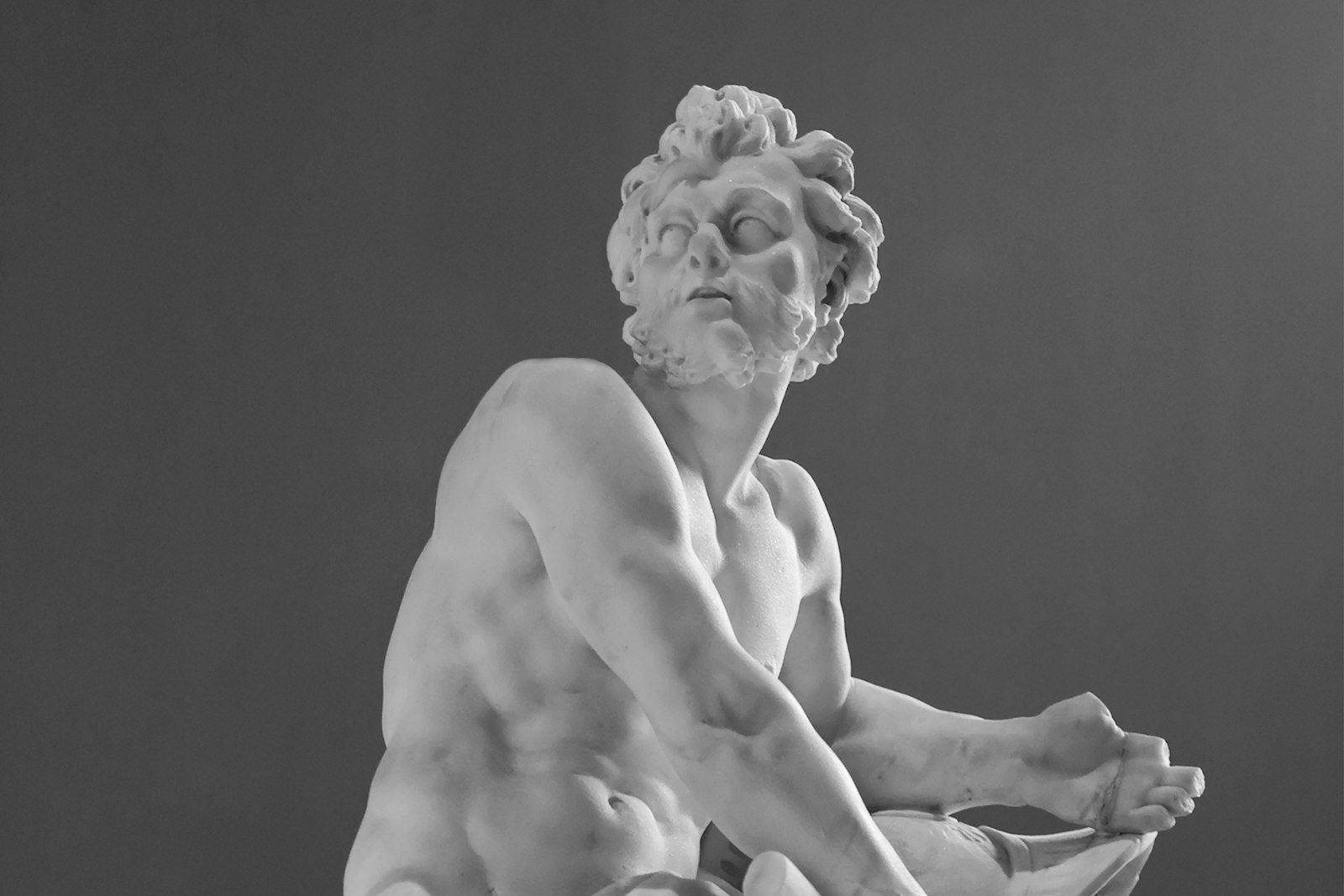
-
Hephaestus had a "shriveled human foot" that was either the reason for--or the result of--his mother casting him out of Olympus (in that location are different versions).
-
In virtually traditions, Hephaestus was married to the Greek goddess of love and passion, Aphrodite, only they profoundly disliked each other. In other versions, however, Hephaestus had a happier marriage to the goddess Charis.
-
Hephaestus's most famous symbols were the tools of his blacksmithing trade: a hammer, an anvil, and a pair of tongs.
God of the kiln, master of metallurgy, and patron of all artisans, Hephaestus was the deft and dexterous craftsman of Mount Olympus. He was worshipped as one of the Twelve Olympians throughout the Greek world and had major cult centers at Athens and on the island of Lemnos.
While Hephaestus resided among the gods equally an artisan and trap-setter, he nevertheless oftentimes plant himself unloved and unwanted by the other gods. In his mythology, Hephaestus was mistreated and rejected by many of the gods, including his mother, Hera, his wife, Aphrodite, and the supremely powerful Zeus. But Hephaestus could also hold his own among the Olympians, and he commonly found creative ways to get back at his abusers.
#Etymology
Equally with many Greek deities, there is no reliable etymology for the name "Hephaestus." The first known recording of the name (or a form of it) is in an inscription on the palace at Knossos on Crete, where it appears as a-pa-i-ti-jo in the syllabic Linear B script used in Statuary Age Greece (ca. 1600–1100 BCE).
The palace at Knossos was a relic of the Minoan people who lived more than than a thousand years before the Greek classical period (490–323 BCE), indicating that the word was nowadays in early Greek society. However, scholars have mostly interpreted the proper noun that appears on this inscription as theophoric—that is, as a proper name that contains the name of the god, rather than the name of the god itself (similar to later Greek names such as Hephaestion).1
Today, the etymology of Hephaestus' name is usually thought to have been pre-Greek.2
#Pronunciation
-
English
Greek
Hephaestus
Ἥφαιστος
-
Phonetic
IPA
[hi-FES-tuhs]
/hɪˈfɛs təs/
#Other Names
Hephaestus' Roman counterpart was chosen Vulcan.
#Epithets
Many of Hephaestus' epithets referred to his physical advent or his lameness, such as amphigyeis ("the lame one") and kyllopodiōn ("foot-dragging"). Other epithets were more positive, emphasizing Hephaestus' skills as a craftsman and smith. These epithets included klytotechnēs ("famous artificer"), polymētis ("shrewd"), and chalkeus ("bronze-working").
#Attributes
#Domains
Hephaestus was the god of crafts of all kinds, peculiarly metalworking. He was also the god of fire, and his workshop was said to exist located (appropriately) beneath a volcano.
#Iconography
Hephaestus was usually depicted equally a burly human being, either bearded or unbearded. Due to his lameness, he lacked the physical perfection of the other Olympians, and in that location are artistic representations that call attention to his crippled legs. In art, Hephaestus was generally dressed simply, in a tunic and a cap called a pilos. He was distinguished by his attributes, the tools of his trade: an ax, double hammer, tongs, bellows, and firebrands.
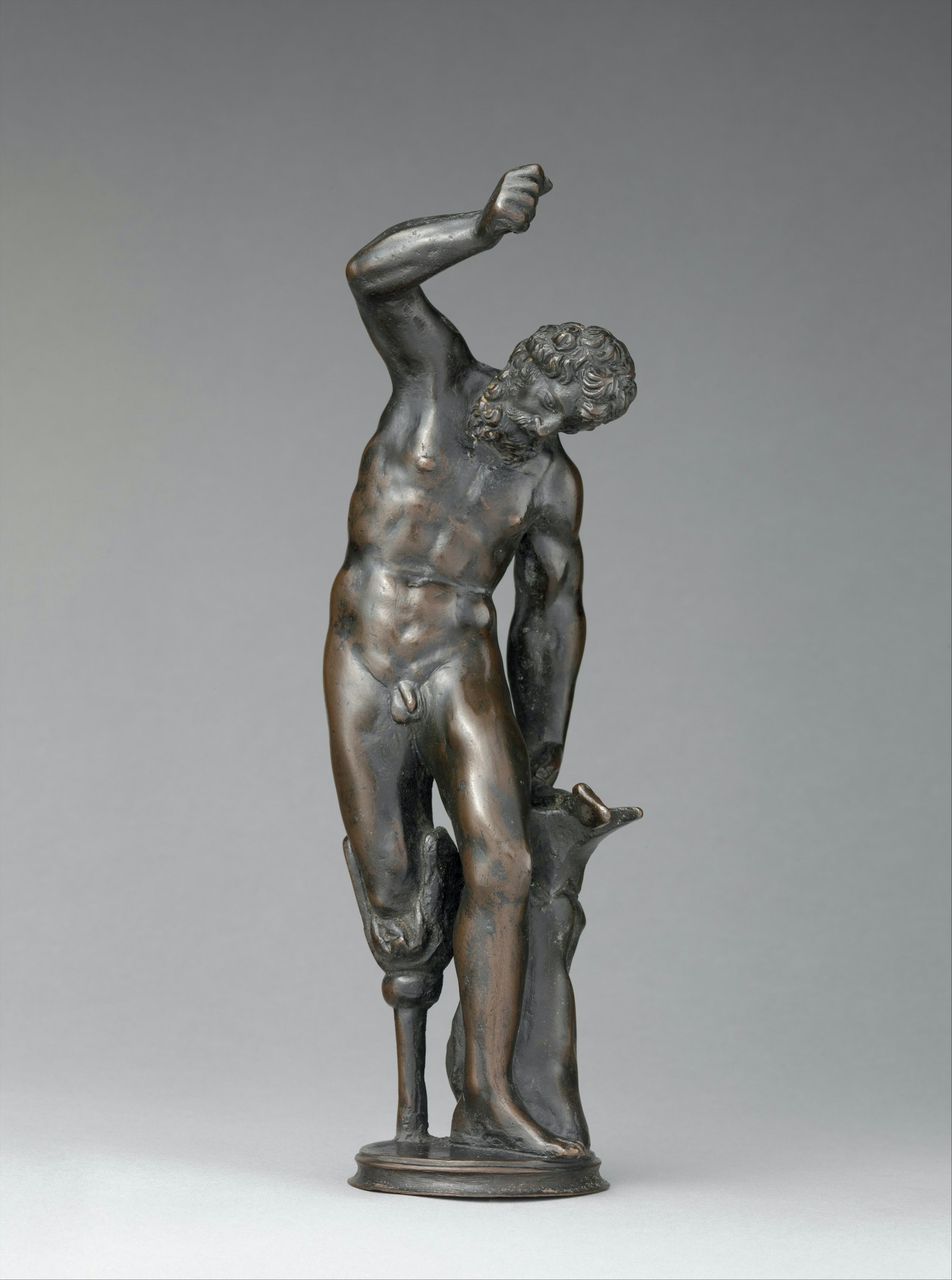
This tardily 16th century Italian statue depicts a crippled Hephaestus (Vulcan was his Roman name) at the forge, as is indicated past the anvil and what appears to have been a blacksmith'south hammer in his right hand. Hephaestus was rarely depicted in statuary form in the ancient world.
Metropolitan Museum of Art / Public DomainThough somewhat removed from the other gods, Hephaestus did take an entourage of his own, consisting of the giant, ane-eyed Cyclopes, who served as his helpers at his workshop. The god was sometimes also shown riding atop a donkey.
#Family
While it is known that Hephaestus was the son of Hera, the rest of his origin remains cloudy due to differences in the stories of his formulation and birth. Co-ordinate to the Homeric epics, the earliest Greek literary texts, Hephaestus' begetter was Zeus.iii But co-ordinate to Hesiod, the second of the great Greek ballsy poets, Hephaestus did not have a father at all: Hera, says Hesiod, became angry with Zeus when he gave nascence to Athena without her and determined to have a child of her own without Zeus.4
According to the almost familiar tradition, Hephaestus married Aphrodite, the goddess of love and sexual practice. But in the Iliad, Homer calls Hephaestus' wife Charis,5 and in the Theogony, Hesiod calls her Aglaea.6
Although Hephaestus was not as desirable as his brethren gods, he did reproduce. By far his most of import child was Erichthonius, who was built-in when Hephaestus attempted to rape Athena but ended up spilling his seed on the world. Erichthonius would grow up to become the founding hero of the neat city of Athens.
Some other son of Hephaestus was Periphetes, known every bit the "Club Wielder," a abominable man with one eye and a lame leg similar his male parent. He lurked on the roads near Athens, robbing travelers, until the mortal hero Theseus slayed him.seven
In some traditions, Hephaestus also fathered Palaemon, one of the Argonauts who sailed with Jason to fetch the Aureate Fleece.8
Hephaestus had a handful of other children with other goddesses and mortal women, only none with Aphrodite.
#Family Tree
-
Parents
father
mother
- Zeus
- Hera
-
Siblings
brothers
sisters
- Apollo
- Ares
- Dionysus
- Hermes
- Heracles
- Minos
- Perseus
- Rhadamanthus
- Artemis
- Athena
- Persephone
- Aphrodite
- Eileithyia
- Hebe
- Helen of Troy
- Graces
- Muses
- Moirae
-
Consorts
wives
- Aphrodite
- Aglaea
- Charis
-
Children
sons
- Erichthonius
- Palaemon
- Periphetes
#Mythology
#Birth and Expulsion
A central aspect of the Hephaestus mythos—and ane frequently depicted in both ancient and modern fine art—was his expulsion from Olympus, likewise equally his eventual return. This story saw two chief variations:
-
After Hephaestus was born, his female parent, Hera, was disgusted when she found out that the child had a malformed foot. Deeming Hephaestus unworthy of divinity, Hera threw him down to globe. Later on his fall, however, Hephaestus was discovered by the Nereid Thetis and some of her sisters, who kindly nursed him dorsum to health.9
-
In another story, it was Zeus who cast Hephaestus out of heaven considering the lame god had tried to come to his mother's assistance after she angered Zeus. Hephaestus fell for a full day before landing on the island of Lemnos (this spot, the "Lemnian globe," became a sacred site for pilgrims of Hephaestus, who claimed that it possessed healing powers). This fourth dimension, it was the Sintian people who helped Hephaestus.10
These may or may non have been multiple variants of a unmarried myth. Both of them, interestingly, feature in Homer's Iliad: there, the first fall is said to accept taken identify right after Hephaestus was born, while the 2d took place when he was already fully grown.
Yet some sources combine the versions, or make them into mutually incompatible alternatives: the mythographer Apollodorus, for example, writes that Hephaestus was cast out of heaven by Zeus for trying to assistance his mother, Hera (equally in the second account) and that he was saved past Thetis (as in the first account). He then goes on to say that Hephaestus only became bedridden as a result of his fall; this would imply that the outset fall of Hephaestus—when he was thrown out of heaven because of his lame, malformed feet—could not have happened.11
#The Return of Hephaestus
Either way, Hephaestus was understandably troubled by the incident and refused to return to Olympus. To avenge himself (based on the first account), Hephaestus congenital a trap for Hera—a chair with a hush-hush mechanism. Once Hera sat on the chair, it locked her in identify.
For some fourth dimension, Hephaestus wandered the world and refused to release Hera from the chair. He eventually returned to his proper place on Olympus, albeit not by his ain volition. Co-ordinate to most stories, Hephaestus was wined past Dionysus, who gave him plenty of his vineyard's finest to ensure that he slept soundly; in one case Hephaestus was resting peacefully, the wine god placed him on a ass that carried him to the top of Mount Olympus. One time there, he finally consented to release his female parent and forgive her.12
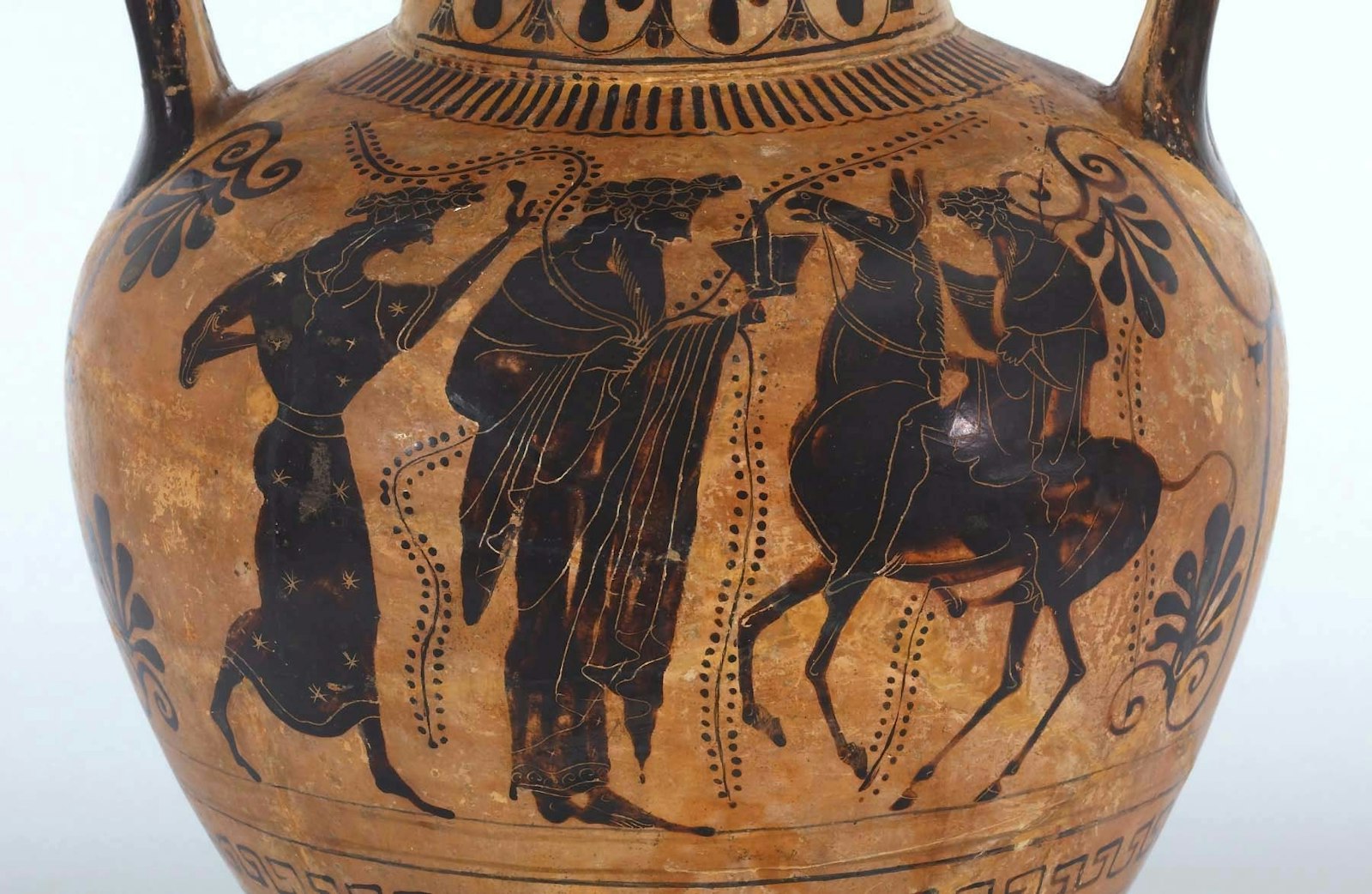
The lame Hephaestus appears on a donkey with Dionysus every bit the cardinal figure of this vase painting attributed to the circle of the Antimenes Painter (ca. 520 BCE). This famous and comedic scene was depicted often on pottery made in Attica and Corinth.
Walters Art Museum / CC0In other traditions, however, Hephaestus trapped Hera on the chair because, having been bandage out of Olympus as an baby, he did not know who his parents were. As shortly equally Hera revealed that she was his female parent, Hephaestus let her go.13
#Hephaestus, the Craftsman
Hephaestus was non usually the center of myths; he seldom figured as the hero in dramatic tales, took fewer lovers than his brothers and sisters, and was less conspicuous overall. Unlike most of the other gods, he was often a ridiculous or comedic effigy, in part considering of his disability.
Just Hephaestus was non to be underestimated. He was cunning and vengeful, often earning small victories. Such triumphs came from his tremendous skill equally an artisan and his ability to contrive clever traps and tricks. Hephaestus' masterful skill and ingenuity resulted in the creation of well-nigh everything unique or sophisticated in Greek mythology.
Hephaestus ran a massive workshop on Mountain Olympus, complete with xx bellows, a forge, and an anvil. Hephaestus also boasted a retinue of assistants, including non only several Cyclopes simply as well automata, which the clever god had crafted himself. Homer described these marvelous creations in the Iliad as "handmaidens wrought of gold in the semblance of living maids. In them is understanding in their hearts, and in them oral communication and strength, and they know cunning handiwork past souvenir of the immortal gods."14
In later traditions, Hephaestus also had workshops in other, even more exotic locations. Some sources, for example, placed Hephaestus' workshop at or near the volcanic Mount Etna in Sicily.fifteen Others placed the workshop on the island of Lemnos, said to be especially sacred to Hephaestus.16
Hephaestus fashioned countless beautiful things for gods, kings, and heroes, including palaces, temples, statues, armor and weapons, and jewelry. Among his almost famous creations were aegis (the mighty shield used past Zeus and Athena);17 the necklace of Harmonia, sometimes said to curse whoever wore information technology (this was Hephaestus' revenge on his wife, Aphrodite, who produced Harmonia through her adulterous matter with Ares);18 and the armor of diverse heroes, including Heracles,nineteen Achilles,20 and Aeneas.21
#Aphrodite and Ares
Hephaestus married Aphrodite, the most beautiful of all the goddesses, but their marriage was an unhappy i. In a famous scene from the Odyssey, a bullheaded poet named Demodocus sings of how Hephaestus discovered that his wife was having an affair with Ares, the god of war.
Hephaestus, the story goes, hatched a plan to catch Aphrodite and Ares in the deed. He went to his workshop and created a net then fine that it could not be seen by the naked eye. He so placed the net over his bed; when Aphrodite and Ares, thinking Hephaestus was abroad, went to Hephaestus' bed to have sex activity, Hephaestus trapped them in the net and called all the gods over to look upon the ridiculous scene.
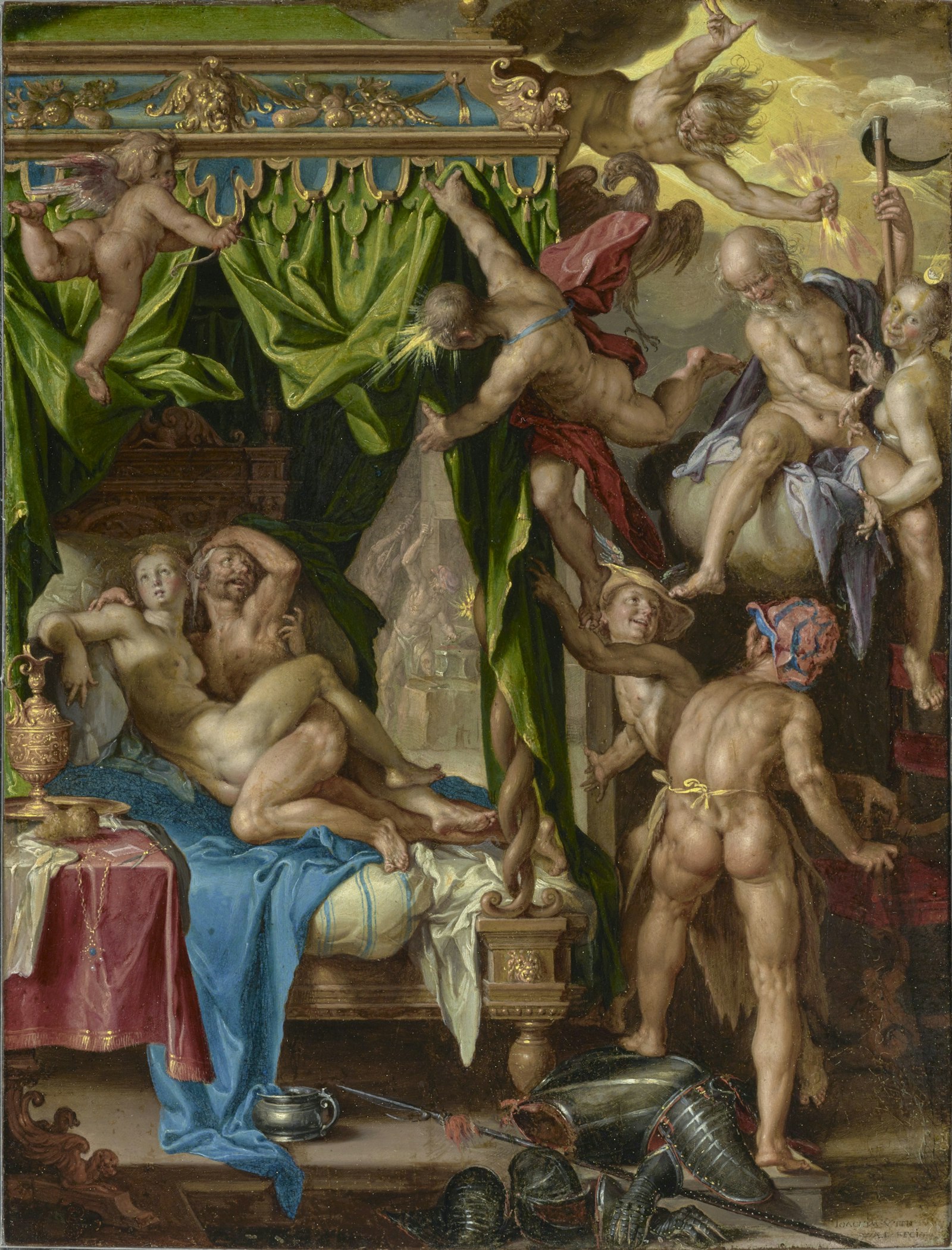
Mars and Venus Surprised past Vulcan by Joachim Wtewael (1604–1608).
"Shortly shall both lose their desire to sleep," says Homer'south Hephaestus, complaining about his cheating wife, "merely the snare and the bonds shall agree them until her father pays back to me all the gifts of wooing that I gave him for the sake of his shameless daughter; for his daughter is fair but bridles not her passion."22
All the gods laughed heartily at the scene—all except Poseidon, the god of the sea, who insisted that Hephaestus let Ares and Aphrodite go. Hephaestus finally agreed; released from Hephaestus' adamantine net, Ares and Aphrodite both fled the scene, aback.23
With this colorful depiction of their human relationship in heed, it was unsurprising that Hephaestus and Aphrodite had no children together.
#Athena and Athens
In another important myth, Hephaestus played a key role in the foundation of Athens. It began when Hephaestus commencement took an interest in Athena. Hephaestus and Athena, incidentally, were often viewed as analogue deities. Both were creators and benefactors who brought the gifts of wisdom, creativity, and craft to humankind.
Co-ordinate to one version of the story, Hephaestus attempted to rape Athena, simply she eluded him just as he was almost to consummate the deed, causing him to ejaculate on the ground. His spilled semen impregnated Gaia, and out of the earth sprang Erichthonius, a prince raised by Athena who would become an early ruler of Athens.24
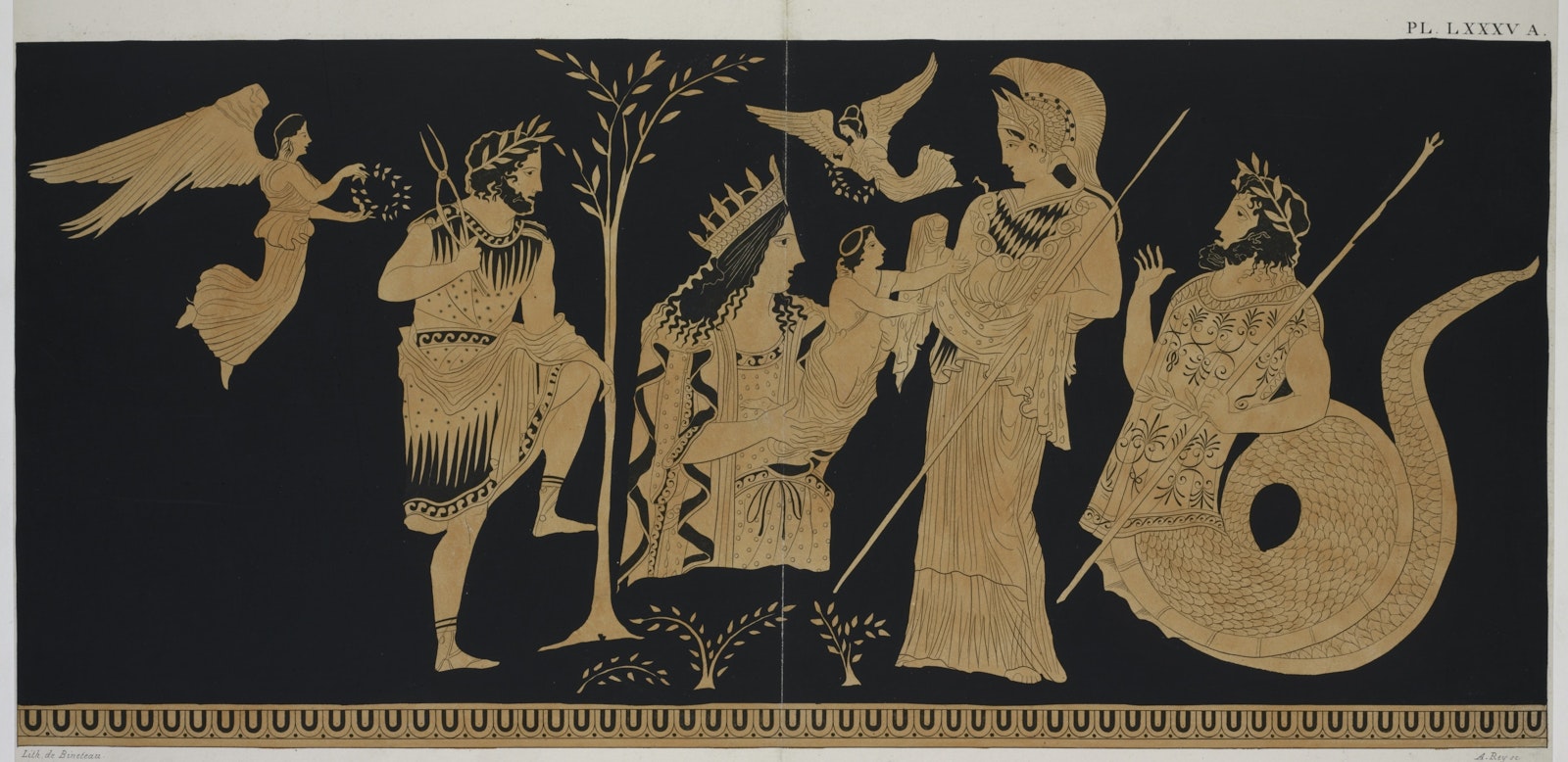
This 19th century lithograph of ancient Greek pottery design shows the birth of Erichthonius. Hephaestus, holding the tongs of a blacksmith, stands backside Gaia as she presents Erichthonius to Athena.
New York Public Library / Public DomainIn another (less familiar) version, Hephaestus earned Athena'south hand in marriage because he had, in a sense, helped to deliver her; he had done and so by splitting Zeus' head open as she began to sally from information technology. While Zeus gave his blessing to Hephaestus, Athena remained reluctant. In the marriage bed, when Hephaestus was about to consummate the marriage, Athena lost her nerve and fled, causing Hephaestus to ejaculate upon the earth. In this version as well, Hephaestus' spilled seed gave rise to Erichthonius.25
Whatever the exact details, Hephaestus' kid Erichthonius went on to go one of the founding figures of the great city of Athens. Like many children born from the earth, Erichthonius was sometimes depicted every bit having serpent features, though he was still regarded as a cracking king and the ancestor of the Athenian people.
#Hephaestus and the Trojan State of war
According to the Iliad, it was Hephaestus who fabricated Achilles a new gear up of armor when his previous set was stripped from the corpse of Patroclus past the Trojan hero Hector. (Achilles' friend Patroclus had donned the monumental armor in a fatal endeavour to scare the Trojans away from the Greek military camp.) The shield was especially magnificent, decorated with elaborate scenes illustrating every facet of man life; it is described in detail by Homer.26
Later, Hephaestus helped Achilles fight off the river god Scamander. Achilles was on a rampage, killing countless Trojan warriors and throwing their corpses into the Scamander River. The river god, choking on bodies and blood, tried to drown Achilles in his rushing waters. The great hero might have perished then and there if Hera had not sent Hephaestus to aid him. Hephaestus threatened to scorch Scamander and his river with fire if he did not leave Achilles alone; Scamander immediately did as he was asked.27
#Other Myths
Hephaestus featured in a handful of other myths. In the terrible war between the Olympian gods and the so-chosen Giants (monsters born to the primordial world goddess Gaia), Hephaestus killed the Giant called Mimas.28
In another important (and deeply misogynistic) myth—recounted by Hesiod in two dissimilar poems29—Zeus sought to punish humanity for the theft of fire past presenting them with the start woman. This adult female was designed to unleash every believable evil on humanity and was, ironically, named Pandora ("all-gifted"). Naturally, it was the skilled craftsman Hephaestus who was tasked with creating Pandora.
#Worship
#Festivals
The most well-known aboriginal festivals of Hephaestus were historic in Athens, where, every bit the father of the founding hero Erichthonius, he was peculiarly revered. The Hephaestia, celebrated every four years, involved a torch race and sacrifices to the god.thirty In another festival, the Chalkeia, craftsmen walked in a procession through the urban center in honor of Hephaestus and his analogue Athena.31
In unlike parts of the Greek world, Hephaestus was also connected with the mystery cult of the Cabiri (whom he was said to have fathered).32 These mysteries virtually probable involved initiation rites, feasting, and sacrifices; they were skilful primarily in Asia Minor, Macedonia, Boeotia, and some northeastern Aegean islands.
#Temples
The public cult of Hephaestus was not as widespread in Hellenic republic equally that of nearly of the other Olympians. Hephaestus did, notwithstanding, have important cult centers at Lemnos, an Aegean island that was specially sacred to him, and Athens, where he was worshipped together with Athena equally one of the city's chief patron gods.

The Temple of Hephaestus, sometimes erroneously chosen the Theseum, in the agora of Athens.
At Lemnos, the spot where Hephaestus supposedly landed when he was thrown from heaven was an especially sacred site. It was believed that this spot could cure diverse ailments, including ophidian bites.33
There was a large temple of Hephaestus, called the Theseium, most the agora of Athens; in it, the cult statue of Hephaestus stood adjacent to that of Athena.34
Hephaestus also had a scattering of temples in Sicily, where he was sometimes said to take had a workshop.
#Pop Civilisation
Hephaestus has enjoyed a lively presence in popular media. In films and boob tube based on Greek mythology, he usually appears as a powerful, thick-armed craftsman in the archetypal blacksmith mode. In the 1981 film Clash of the Titans, he was played by the large British wrestler Pat Roach. In the television series Hercules: The Legendary Journeys and Xena: Warrior Princess, meanwhile, he appeared as a large, leather-clad blacksmith played by actors Julian Garner and James Hoyte.
In video games, too, Hephaestus is a renowned crafter of items. In the God of War series, he makes weapons for the protagonist, Kratos. In the classic video game Diablo Ii, a crazed blacksmith and dungeon principal is named Hephaesto in a clear homage to the Greek deity.
Finally, Hephaestus plays a function in the popular Percy Jackson and the Olympians book serial by Rick Riordan—a series that has reignited interest in Greek mythology. In the fourth volume, The Battle of the Labyrinth, Hephaestus appears as the primary of the kiln, with a workshop that pumps out finely-tuned objects. Because the novel is a modern retelling, however, his most notable human action is repairing an old Toyota that had cleaved downward.
Farther Reading
#Main Sources
Greek
-
Homer: Hephaestus appears in the Iliad and the Odyssey (eighth century BCE) as the craftsman of Mount Olympus; in the Iliad, he makes a stunning accommodate of armor for Achilles.
-
Hesiod: Hephaestus' genealogy and mythology are described in the seventh-century BCE epics of Hesiod, including the Theogony and the Works and Days. In the Shield of Heracles (traditionally, but dubiously, attributed to Hesiod), Hephaestus is the ane who makes Heracles' armor and shield.
-
Homeric Hymns: The twentieth Homeric Hymn (seventh or sixth century BCE) is defended to Hephaestus.
-
Pindar: Hephaestus does not make very many appearances in Pindar's poesy (fifth century BCE), though he does play a role in Olympian Ode vii as Zeus' "midwife" during the nascency of Athena.
-
Aeschylus: In the tragedy Prometheus Bound (a 5th-century BCE tragedy that may or may non take actually been written by Aeschylus), it is Hephaestus who chains Prometheus to the mountain where his punishment for stealing the gods' fire is to take identify.
-
Apollonius of Rhodes: At that place are references to the famous workshop of Hephaestus in Book 4 of the 3rd-century BCE epic Argonautica, which tells the story of Jason and the Argonauts.
-
Callimachus: In the tertiary Hymn, defended to Artemis, it is Hephaestus who gives Artemis her weapons.
-
Orphic Hymns: The Orphics were a Greek cult that believed a blissful afterlife could be attained by living an ascetic life. Orphic Hymn 65 (third century BCE to second century CE) is dedicated to Hephaestus.
-
Strabo, Geography: A late start-century BCE geographical treatise and an important source for many local Greek myths, institutions, and religious practices from artifact.
-
Lucian: Hephaestus features in Lucian's satirical Dialogues of the Gods (belatedly beginning to early second century CE).
-
Pausanias, Description of Greece: A second-century CE travelogue; similar Strabo's Geography, an important source for local myths and customs.
-
Quintus of Smyrna: In the 4th-century CE epic Posthomerica, as in the Homeric epics, Hephaestus plays a pocket-sized part as the Olympian craftsman.
-
Nonnus: In the epic poem Dionysiaca (fifth century CE), which relates the adventures of the immature god Dionysus, Hephaestus is recruited by his mother, Hera, to help the Indians fight against Dionysus.
Roman
-
Virgil: Vulcan (the Roman equivalent of Hephaestus) appears in his typical epic role in Book 8 of the Aeneid (19 BCE), making a suit of armor for the protagonist Aeneas.
-
Ovid: The myths of Vulcan/Hephaestus feature in some of Ovid'due south verse, such every bit the Metamorphoses (ca. 8 CE).
-
Statius: The fifth poem of Book 1 of the Silvae (first century CE) is one of the only works to present a positive epitome of the relationship between Vulcan/Hephaestus and Venus/Aphrodite. In Statius' epic Thebaid, however, the married couple is back to their typical grouse and jealousy.
Mythological Handbooks (Greek and Roman)
-
Diodorus of Sicily, Library of History: A work of universal history, covering events from the creation of the creation to Diodorus' ain time (mid-get-go century BCE). Contains references to Hephaestus.
-
Apollodorus, Library: A mythological handbook from the get-go century BCE or the first few centuries CE with references to Hephaestus.
-
Hyginus, Fabulae: A Latin mythological handbook (first or second century CE) that includes sections on the myths of Vulcan/Hephaestus.
-
Fulgentius, Mythologies: A Latin mythological handbook (5th or sixth century CE) with sections on the myths of Vulcan/Hephaestus.
#Secondary Sources
-
Burford, Alison. Craftsmen in Greek and Roman Order. Ithaca, NY: Cornell University Press, 1972.
-
Burkert, Walter. Greek Religion. Cambridge, MA: Harvard University Press, 1985.
-
Cartwright, Mark. "Hephaistos." World History Encyclopedia. Published online 2019. https://world wide web.worldhistory.org/Hephaistos/.
-
Gantz, Timothy. Early Greek Myth: A Guide to Literary and Artistic Sources. 2 vols. Baltimore, Medico: Johns Hopkins University Press, 1996.
-
Graf, Fritz, and Anne Ley. "Hephaestus." In Brill's New Pauly, edited by Hubert Cancik, Helmuth Schneider, Christine F. Salazar, Manfred Landfester, and Francis Chiliad. Gentry. Published online 2006. http://dx.doi.org/x.1163/1574-9347_bnp_e507970.
-
Graves, Robert. The Greek Myths. London: Penguin, 1955.
-
Guthrie, W. Chiliad. G. The Greeks and their Gods. London: Methuen, 1962.
-
Kerényi, Károly. The Gods of the Greeks. London: Thames and Hudson, 1951.
-
Long, C. R. The Twelve Gods of Greece and Rome. Leiden: Brill, 1987.
-
Rose, H. J. A Handbook of Greek Mythology. London: Methuen, 1929.
-
Smith, William. "Hephaestus." In A Dictionary of Greek and Roman Biography and Mythology. London: Spottiswoode and Company, 1873. Perseus Digital Library. Accessed May 27, 2021. http://world wide web.perseus.tufts.edu/hopper/text?doc=Perseus%3Atext%3A1999.04.0104%3Aalphabetic+letter%3DH%3Aentry+group%3D6%3Aentry%3Dhephaestus-bio-1.
-
Theoi Project. "Hephaistos." Published online 2000–2017. https://www.theoi.com/Olympios/Hephaistos.html.
Source: https://mythopedia.com/topics/hephaestus
0 Response to "Why Was Hephaestus Was a Patron of the Arts"
Post a Comment